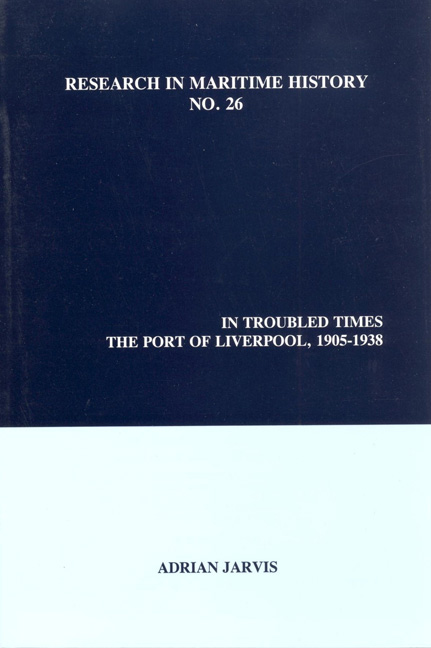Book contents
- Frontmatter
- Table of Contents
- List of Figures
- Foreword and Acknowledgements
- Conversion Factors for Imperial Measurements
- Introduction: The Port of Liverpool in 1905
- Chapter 1 The Port and Its Trade in 1905
- Chapter 2 Gladstone Dock
- Chapter 3 Not Before Time: The Board Keeps its Promise
- Chapter 4 Engineering, Management and Decision-making
- Chapter 5 Making the Customers Happy
- Chapter 6 Sand, Silt and Sewage: The Work of the Board's Dredgers
- Chapter 7 The Provision of Specialist Cargo Facilities
- Chapter 8 Into the Modern World?
- Conclusion: On the Eve of War
- Appendix: Port Efficiency: A Short Methodological Discourse
- A Note on Sources: Abbreviations
- Bibliography
- Index
Chapter 4 - Engineering, Management and Decision-making
- Frontmatter
- Table of Contents
- List of Figures
- Foreword and Acknowledgements
- Conversion Factors for Imperial Measurements
- Introduction: The Port of Liverpool in 1905
- Chapter 1 The Port and Its Trade in 1905
- Chapter 2 Gladstone Dock
- Chapter 3 Not Before Time: The Board Keeps its Promise
- Chapter 4 Engineering, Management and Decision-making
- Chapter 5 Making the Customers Happy
- Chapter 6 Sand, Silt and Sewage: The Work of the Board's Dredgers
- Chapter 7 The Provision of Specialist Cargo Facilities
- Chapter 8 Into the Modern World?
- Conclusion: On the Eve of War
- Appendix: Port Efficiency: A Short Methodological Discourse
- A Note on Sources: Abbreviations
- Bibliography
- Index
Summary
The previous chapter raises a major question. How could the engineering of the Clarence modernisation project go so well, when the modernisation of Alfred Entrances on the Birkenhead side just a short while before had seen a breakdown in organisation which verged on the scandalous and resulted in fifty-percent overspending on each of the two major elements of the job, together with long schedule over-runs? The Works Committee appointed a Special Committee to investigate, which found terrible lapses of communication between the men in the office and the men on the ground. It also found attempts to conceal overspending. It seems likely there was much else that it did not find, or at least record, including the following little episode.
When the Traffic Committee was engaged in a budgeting process in 1928, the following items appeared in its estimates for 1928-1929: Mersey Cattle Wharf, re-glaze slaughterhouse, cooling and chill room avenues; re-glaze Nos. 1, 2 and 3 sheds, Wallasey Dock and Glass House [lairage]; and re-glaze various panes in other adjacent sheds. Albert Foulkes, Chief Traffic Manager, suggested that as this work was “consequent upon the excavation and blasting in connection with Alfred Dock Works” it should be charged to those works. The same minutes record that “the Engineer-in-Chief is of opinion that only a portion of the damage was caused through blasting. ” The list includes every building within 300 yards of the south wall of Alfred's south entrance, and the incompetence in the use of explosives necessary to achieve such destruction clearly implies serious failures in training, supervision and communication. Quite simply, the laying and detonation of charges had been entrusted to someone who was a danger to himself and to everyone else for a considerable radius. There was an established professional literature on the use of explosives, which was useless if the person who determined the size, location and number of charges had not read it, including a paper specifically dealing with very similar work to that being undertaken at Alfred which described practices which, if carried out would have ensured a safer and cheaper outcome. In the other major industries where blasting was routine, such as mining and quarrying, it was illegal to entrust untrained men with high explosives, but in engineering construction or demolition it was perfectly legal, if extremely foolish, to do so.
- Type
- Chapter
- Information
- In Troubled TimesThe Port of Liverpool, 1905-1938, pp. 91 - 112Publisher: Liverpool University PressPrint publication year: 2003



